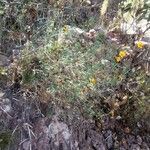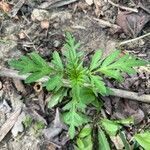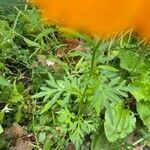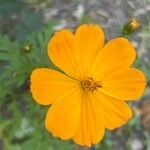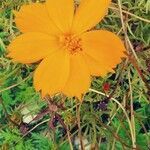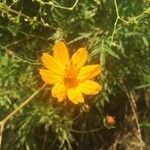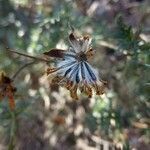Annual herb, single stemmed from taproot, branching with age, 0.6–2.1 m high, glabrous to hispid. Leaves ovate in outline, bi-or tripinnatisect, 1–20 cm long (including petiole); petiole 1–7 cm long; ultimate lobes 2–10 mm wide, glabrous or with few hairs along veins. Capitula radiate, terminal and usually solitary, on peduncles 10–20 cm long; outer involucral bracts herbaceous, linear-subulate, 3–10 mm long; inner bracts oblong-lanceolate, 9–13 (–18) mm long, acute to rounded, usually yellowish; paleae narrowly oblong-lanceolate. Ray florets 8 (–10); ligule 18–28 mm long, bright yellow or red-orange. Disc florets 6–7 mm long, yellow. Achenes linear-fusiform, black, 16–28 mm long including the setulose-coronate beak, usually hispid. Pappus awns 2, weak, very slender, 4.5–7 mm long, weakly retrorsely barbed, often fragile and deciduous, sometimes absent.
Plants 30-200 cm tall, glabrous or sparsely pilose to hispid. Leaves petiolate; petiole 1-7 cm; blade 5-12(-25) cm, ultimate lobes 2-5 mm wide, margin sparsely spinulose-ciliate, apex apiculate. Peduncles 10-20 cm; calycular bracts spreading-ascending, linear-subulate, 5-7(-10) mm, apices acute; involucre 6-10 mm in diam.; phyllaries erect, oblong-lanceolate, 9-13(-18) mm, apices acute to rounded-obtuse. Ray corollas intensely yellow to red-orange, lamina obovate, 18-30 mm, apices ± truncate, denticulate. Disk corollas 6-7 mm. Achenes 15-30 mm, usually hispidulous, rarely glabrous; pappus absent, or of 2 or 3 widely divergent awns 1-7 mm. Fl. Jun-Sep. 2n = 24, 48.
Plants 30–200 cm, glabrous or sparsely pilose to hispid. Leaves: petioles 1–7 cm; blades 5–12(–25) cm, ultimate lobes 2–5 mm wide, margins sparsely spinulose-ciliate, apices apiculate. Peduncles 10–20 cm. Calyculi of spreading-ascending, linear-subulate bractlets 5–7(–10) mm, apices acute; Involucres 6–10 mm diam. Phyllaries erect, oblong-lanceolate, 9–13(–18) mm, apices acute to rounded-obtuse. Ray corollas intensely yellow to red-orange, laminae obovate, 18–30 mm, apices ± truncate, denticulate. Disc corollas 6–7 mm. Cypselae 15–30 mm, usually hispidulous, rarely glabrous; pappi 0, or of 2–3 widely divergent awns 1–7 mm. 2n = 24, 48.
Annual herb 0.3–1.2 m high; stem 4-gonous, pubescent to glabrous.. Leaves ovate in outline, deeply dissected, 5–15 cm long and 4–8 cm wide, the segments 2–5 mm wide, glabrous; petiole absent or to 3 cm long.. Capitula solitary and terminal; peduncle 2–22 cm long; involucre with phyllaries 5–12 mm long; paleae 9–10 mm long.. Ray florets 7–10, rich orange or sulphur yellow, 18–30 mm long; disc florets orange-yellow, 7–9 mm long.. Achenes blackish, 16–28 mm long, the beak 6–9 mm long; pappus of 2(–3) retrorsely barbed aristae 4–7 mm long.. Fig. 173 (page 809).
Annual herb 0.3-1.2 m high; stem 4-gonous, pubescent to glabrous. Leaves ovate in outline, deeply dissected, 5-15 cm long and 4-8 cm wide, the segments 2-5 mm wide, glabrous; petiole absent or to 3 cm long. Capitula solitary and terminal; peduncle 2-22 cm long; involucre with phyllaries 5-12 mm long; paleae 9-10 mm long. Ray florets 7-10, rich orange or sulphur yellow, 18-30 mm long; disc florets orange-yellow, 7-9 mm long. Achenes blackish, 16-28 mm long, the beak 6-9 mm long; pappus of 2(-3) retrorsely barbed aristae 4-7 mm long.
A perennial herb. It grows to 1 m high and spreads to 50 cm across. The stem is erect, slender and very delicate. The leaves are finely divided 2 or 3 times, with fine narrow lobes. The flowers are yellow. They are in open, bowl-shaped flower heads, and these are borne in clusters. These are 3.5-6 cm across.
Much like no. 1 [Cosmos bipinnatus Cav.]; ultimate lf-segments broadly linear to lanceolate, mostly (1.5–)2 mm wide or more; rays intensely orange-yellow or orange-red, 2–3 cm; achenes 15–30 mm; 2n=24. Native of trop. Amer., cult. and casually escaped toward the s. part of our range, and n. to Pa. Aug.–Oct.
